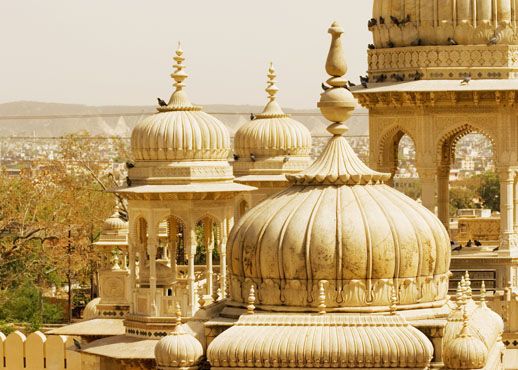Surrounded on three sides by the rugged Aravali hills, Jaipur is the picturesque capital of Rajasthan. It takes its name from the prince, soldier and astronomer J Singh II, who moved his capital here in 1727. The old capital, Amber (or Amer), had, long been a stronghold of Rajput power, but had become too cramped at its mounta site. Although it had been attacked by various rulers of Delhi the Kachhwaha rule were secure in the Jaigarh fort. When the Mughals arrived Maharajah Mansingh (t then ruler of Amber) guaranteed the safety of his kingdom on becoming a gene) and minister in Akbar’s court and by giving his sister to the Emperor in marriage With his new position and wealth Man Singh built the imposing fort-palace of Anil below the earlier fort. But the Kachhwahas of Amber were seen by other Rajput as having sold out, a blot on her record which transferred to Jaipur, and which time has not erased.
Jai Singh built Jaipur as a planned city. It is divided into seven rectangular bloc built on a grid of nine squares as detailed in the Shilpa Shasta, an ancient Hindu architectural treatise. The broad well-laid-out main streets (33.8 m: 110 ft wide) cut the side lanes at sharp right-angles. The entire city is encircled by fortified, crenellated walls, and guarded by seven gates.
An attraction of Jaipur is its distinctive pink-orange colouring. The whole of the old city, including many fine palaces and buildings, was constructed from solid blocks of sandstone or faced with the same stone. But it was only in 1853, when Prince Albert visited and the city was painted pink for the first time that it gained , its famous title of the ‘Pink City’. The soft glow of its buildings and monuments, most magical at sunset, have fascinated visitors for over two centuries.
Jaipur is the real gateway to Rajasthan. Though a very busy, commercial capital, the underlying Rajput spirit stubbornly lives on. The traditional dress, decoration and colour can be seen everywhere—the station porters in bright red turbans and jackets, the veiled women in loose-flowing robes of red, orange and yellow, the tiny khol-eyed infants in swaddling clothes of rich, embroidered silk. Inside the old city, them atmosphere is electric—a bustling, jolly round of ringing bicycle bells, teeming traffic, itinerant sacred cows, busy bazaars and tourist-hungry rickshaws.
Situated on the plains, Jaipur gets pretty hot. Coolest from October to February, busiest and most popular from January to March, it remains pleasant to mid-April (nDot too hot but less crowded). Two important dates for your diary are the Elephant Festival just before Holi in March and the spring festival of Gangaur in March/April which culminates on the 17th day after Holi when the Goddess Gauri (Parvati) is ‘paraded from the City Palace and through the city streets. The Teej festival during early August is an important festival for local women and celebrates the monsoon.


